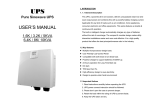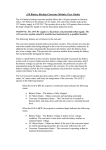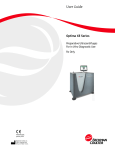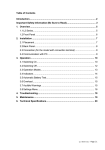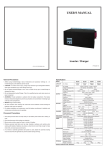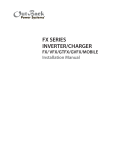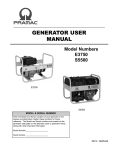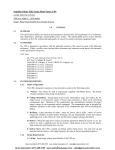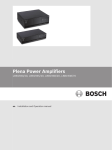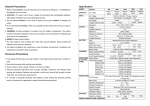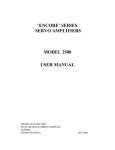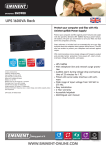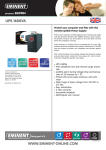Download Inverter + UPS User Manual
Transcript
Inverter + UPS Home Inverter series User Manual Sine Wave Output IMPORTANT SAFETY INSTRUCTIONS ● When replacing the batteries, use the same number and the same type of batteries. ● Do not dispose of batteries in a fire; the battery may explode. ● Do not open or mutilate the battery or batteries, released electrolyte is harmful to the skin and eyes. ● A battery can present a risk of electric shock and high short circuit current. The following precaution should be observed when working on batteries. * Remove watches, rings or other metal objects. * Use tools with insulated handles. ● To prevent an overbalance of this unit, with the installation the additional stabilizer are to mount at the bottom side. ● This unit should be installed by service personnel. ● The equipment can be operated by any individuals with no previous experience. ● “The socket-outlet shall be installed near the equipment and easily accessible.” ● “With the installation of this equipment it should be prevented, that the sum of the leakage current of the inverter at the connected consumer does not exceed 3.5mA.” ● Attention: hazardous through electric shock. Also, with disconnection of this unit from the main, hazardous voltage still may be accessible through supply of battery. ● The battery supply should be therefore disconnected in the plus and minus pole through or from the outer enclosure accessible battery fuses when maintenance or service work inside the inverter is considered. ● The lead acid battery may cause chemical hazard. ● The battery presents a risk of electric shock and energy hazard. ● Batteries will be disposed by the manufacturer or importer. Customers need to send them back with no charge for disposal. SAVE THESE INSTRUCTION. This manual is important instructions that you should follow during installation and maintenance of the Inverter and batteries. Please read all instructions before operating the equipment and save this manual for future reference. 1 CAUTION: ● The inverter connection instructions and operation described in the manual must be followed in the indicated order. ● The inverter must be connected to a near by wall outlet that is easily accessible. The inverter can be disconnected from the AC-power source by removing the power cord. ● Check that the indications on the rating plate correspond to your AC-power system and to the actual electrical consumption of all the equipment to be connected to the inverter. ● Never install the inverter near liquids or in an excessively damp environment. ● Never let a foreign body penetrate inside the inverter. ● Never block the ventilation grates of the inverter. ● Never expose the inverter to direct sunlight or source of heat. ● If the inverter must be stored prior to installation, storage must be in a dry place. ● The admissible storage temperature range is -15℃ to +55℃. ● All handling operations will require at least two people (unpacking, installation in rack systems). ● Once installed and connected to the AC power source for the first time, the battery will start to charge. Full charging to obtain the rated battery backup time requires at least 8 hours. ● Before and after the installation, in case of any doubt, do Not hesitate to contact our service department. 2 Special Symbols The following are examples of symbols used on the unit to alert you the important information. RISK OF ELECTRIC SHOCK Indicates that a risk of electric shock is present and the associated warning should be observed CAUTION; REFER TO OPERATOR’S MANUAL Refer to your operator’s manual for additional information, such as important operating and maintenance. SAFETY EARTHING TERMINAL Indicates the primary safety ground. RJ-45 RECEPTACLE For 230V units only, this receptacle provides network interface connections. Do not plug telephone or telecommunications equipment into this receptacle. This symbol indicates that you should not discard the inverter or the inverter batteries in the trash. The inverter & the sealed, lead-acid batteries must be recycled. 3 TABLE of CONTENTS 1. 2. Over view and Features ---------------------------------------------------------- Page 5 Presentation -------------------------------------------------------------------------- Page 6 2.1 LED display models 2.2 LCD display models 2.3 Rear Panels --------------------------------------------------------------------------- Page 7 3. Installation ---------------------------------------------------------------------------- Page 8 4. Operation ------------------------------------------------------------------------------ Page 9 5. Indication and Control ------------------------------------------------------------ Page 12 5.1 LED Display 5.2 LCD Display 5.3 Audible alarm ------------------------------------------------------------------------- Page 14 5.4 Auto self-test Function 5.5 Remote Control ----------------------------------------------------------------------- Page 15 5.6 Reset the Inverter 5.7 DIP Switch Setting 6. Communication interface ------------------------------------------------------- Page 16 7. Trouble shooting ------------------------------------------------------------------- Page 17 8. Specifications ----------------------------------------------------------------------- Page 18 4 1. OVER VIEW AND FEATURES The series Inverter is advanced & friendly designed with pure sine-wave output to your equipment; besides a big charger up to 35A (depending on model), the inverter, unlike the traditional one, also provides a very short transference when blackouts happen; thus, you may apply it as an UPS, too. Further, it is also made with Wide Range AVR, output ±10% with input range as large as 140V ~ 310V in the rated 230V area; or 70V ~ 155V in the 115V area. With the wide AVR, you won't need to use the valuable battery energy when in a brownout. The series provides efficiency over 97% under normal power condition, and 86% under inverter mode. Two charge modes, quick and trickle charge, are applied in the big charger, and so as to maintain the batteries in the best condition. With outstanding performance & reliability, the unique benefits of the inverter include the following: * Pure sine wave output. * Microprocessor based design with true Line-Interactive structure, DC/AC Isolation. * Remaining Estimated Backup Time indication (EBT system on LCD version). * Wide input range 140V~310V for 230V area; and 70V~155V for 115V area. * Adjustable charging voltage & voltage-transfer points. * Smart battery management with intelligent double stages of charging control. * * * * Adjustable charging current by DIP switch for different battery. Real time auto-detection for battery condition. Automatic restart of load after Inverter shutdown. Smart AVR function (Two buck / boost modes). * Generator compatible & Cold-start capable. * “Green Power” design with auto on/off function & adjustable level. * Network manageable (SNMP optional). * Optional RS-232/USB interface for communication, compatible with all major O.S., including Windows, Linux, SCO UNIX, & DOS. * Protection for overload, short circuit, & over heat; also with thermal control cooling fan. * Support Solar panel input for charging (Optional) 5 2. PRESENTATION 2.1 LED display models There are many types of LED display for different models; however, they all use the same control method, the following is an example of it: 1 LEDs of battery voltage level and load level. 2 LED of operation status. 3 Control button. 2.2 LCD display models The following is one example of LCD display; the location of control buttons could be different for some models; however, the functions of buttons are the same. 1 Main control button. 2 LCD screen. 3 Selection button for mode & value. 6 2.3 Rear Panels — Tower type Description of Rear panel in Tower 1. Circuit Breaker for Input. 2. Input Terminal. 3. Output Terminal and / or Outlet(s) (NEMA or IEC). 4. RS-232 Interface port (for application with optional Monitoring software) 5. DIP Switch. 6. RJ-45 Interface for Remote LCD display (Optional). 7. Battery connector. 8. Auto-bypass On/Off Switch (Turn on switch to enable Auto-bypass function). 9. Bypass LED Indicator. 2.3 Rear Panels — Wall-mount type 1600 ~ 4000 800 / 1200 1 Input circuit breaker ○ 7 Battery connector ○ 2 Input terminal of city power ○ 8 Connector for solar panel (Optional) ○ 3 Output circuit breaker for outlets ○ 9 Internal SNMP Slot or USB (Optional) ○ 4 Output terminal & Outlets (IEC or NEMA) ○ 10 Auto-bypass On/Off Switch (Turn on switch ○ 5 RS-232 Interface port ○ to enable Auto-bypass function) 6 DIP Switch ○ 11 Bypass LED Indicator ○ 7 3. INSTALLATION 3.1 Inspecting the packing carton for damage that may have occurred while in transit. Immediately notify the carrier and place of purchase if any damage is found. Retain the package for future use. 3.2 Connect the AC power only to a grounded shockproof wiring system to avoid electric shocks resulted from current leakage. Keep wire length as short as possible to minimize voltage loss. The installation must be performed by qualified personnel. Recommended AC wire size: Capacity \ Input voltage 110/115/120Vac 220/230/240Vac 800VA ~ 1.6KVA AWG14 AWG16 2.4KVA AWG12 AWG14 3.2KVA AWG10 AWG12 4KVA N/A AWG12 3.3 Connecting the DC input power cord with the correct battery voltage and correct polarity, the inverter must be as close as possible to the battery to avoid the voltage drop on the power cord. WARNING: Incorrect polarity may blow fuse and cause internal damage of inverter. Recommended Battery wire size: Capacity Max Current/DC Voltage Wire Size 800VA 70A / 12Vdc AWG 6 1.2KVA 100A / 12Vdc AWG 4 1.6KVA 60A / 24Vdc AWG 8 2.4KVA 90A / 24Vdc AWG 6 3.2KVA 80A / 36Vdc AWG 6 4KVA 75A / 48Vdc AWG 6 3.4 Connecting your equipment to the Inverter. To ensure your home appliances to be powered & protected during a utility failure, it is important to make sure that the maximum power needed by the equipment is not over the rated capacity of the Inverter. Red LED will light up (LED version), or the “Over load” symbol will show up (LCD version), and alarm will beep if the load is over the rated value (the default setting is 100%), and wait for one minute to shutdown when load remains between 100% ~150%. Meantime, if the overload is severe (the default setting is 150%), the Inverter will shut down in two seconds for protecting itself. 8 3.5 Connecting Solar input: Make sure the open circuit voltage of the PV array is less than the DC maximum input voltage of the built-in solar charger. The suggested PV voltage ranges are shown below: 12V models:12 ~ 35Vdc 24V models:24 ~ 42Vdc 36V models:36 ~ 63Vdc 48V models:48 ~ 84Vdc 3.6 Connection concept (For wall-mount 1600VA or above & all Tower units with solar input): 9 4. OPERATION 4.1 Once it’s connected with normal city power, the inverter will charge the battery automatically, when inverter is off, the status LED (in LED version) blinks green every 2 seconds; or in LCD version, the battery symbol and battery level will blink every second during charging. If AC auto turn-on function is enabled, the inverter will turn on automatically when city power is normal. If auto turn-on is disabled, please push the button for about one second on the front panel; then the inverter will give power to the outlets after a short-time of beeping. 4.2 Pushing the button 4 seconds for ‘OFF mode’, the CPU will turn off the power from the AVR or inverter. But, the output relay will transfer to bypass mode automatically. To cut off the auto-bypass power from utility, please turn off the auto-bypass switch. In off mode, inverter will keep charging if city power is normal at 1600VA model or above, charger will stop charging for 800VA and 1200VA models. 4.3 Auto-Bypass: When auto-bypass switch is turned on, the inverter will transfer to bypass mode any time when inverter is turned off. It prevents any power loss to the important equipment if over load or any abnormal situation triggers the shut-down function of inverter. 4.4 DC Start: During a blackout, push the button one second for entering “OFF” mode (LCD showing “OFF” or LED blinking orange); then push again for one second, and the inverter will be turned on and enter into backup mode. To turn off the power from inverter; please push the button for 4 seconds; then the status LED (in LED version) will blink orange every 2 seconds; or LCD display will show “OFF” (in LCD version); then, wait for 10 seconds, and inverter will turn off the power automatically. 4.5 Operation block diagram is shown blow. The auto-bypass switch is available only for 1600VA or above. Bypas s / Sys tem Off Auto bypas s On/Off s witch AC input N.F. I/P RY AVR Surge Protection Bi-direction Inverter / Charger PV Module Solar Charger Battery 10 Sys tem On O/P RY AC output 4.6 DC Priority Mode/Inverter Mode: There are 2 main operation modes when AC utility is normal, the DC priority mode and the AC priority mode. To set DIP SW3 up will enable DC priority mode. In this mode, DC power will be priority and system will draw power from battery when battery voltage is normal. System will automatically switch to AC mode and keep the battery at basic charging level (24V or 36V or 48V) when battery voltage is low. In the DC priority mode, solar charger or fan generator will be the main charger power. The system will not transfer to inverter mode until battery voltage is charged to 13V for each 12V battery. Bypas s / Sys tem Off Auto bypas s On/Off s witch AC input N.F. I/P RY AVR Surge Protection Sys tem On O/P RY AC output Bi-direction Inverter / Charger PV Module Solar Charger Battery 4.7 DC Priority Mode/Green Mode: When load level is low (under 35W), the inverter efficiency is very low. To save the battery energy, user can enable the green mode (set DIP SW4 up). The system will transfer O/P relay to bypass mode at low load level. Please turn on the auto-bypass switch at rear panel under green mode, or the output voltage will become zero when system transfers to bypass mode. Bypas s / Sys tem Off Auto bypas s On/Off s witch AC input N.F. I/P RY AVR Surge Protection Bi-direction Inverter / Charger PV Module Solar Charger Battery 11 Sys tem On O/P RY AC output 4.8 Green mode level setting (by the set-up software, UPS wizard; or through LCD display): When green mode function is enabled, the inverter will turn off the power within 60 seconds in the battery mode with the power consumption lower than the pre-set level (adjustable by using the UPS wizard software). The default value of green mode setting is zero (disabled). 4.9 AC Priority Mode/AC Mode: AC Priority Mode/AC Mode: To set DIP SW3 down will enable AC priority mode. In this mode, the AC O/P power is mainly from AC utility input with AVR (auto-voltage-regulation). The battery charging voltage comes from AC input and converted by the bi-direction inverter to support battery charging power. If the solar charger or fan generator is sufficient, the solar charger will also provide charging power to battery. Bypas s / Sys tem Off Auto bypas s On/Off s witch AC input N.F. I/P RY AVR Surge Protection Sys tem On O/P RY AC output Bi-direction Inverter / Charger PV Module Solar Charger Battery 4.10 Battery charging mode: The inverter provides two charging modes for the battery, quick charging and trickle charging. The quick charging provides higher charging current when battery is empty and reduces the charging current when battery voltage increases. Trickle charging will begin automatically after battery is 90% fully charged. 4.11 When a blackout happens, the buzzer will emit two beeps every 8 seconds for alarm during the first minute of blackout. You can disable the alarm by a short push at the main control button, and to push it again will enable the alarm, the setting can be shown on LCD display. When battery voltage is too low or too high, the inverter will emit alarm, if the under voltage or over voltage is too much, the inverter will turn off itself automatically. Note: The main control button provides test function at normal mode, but will become with alarm-reset function at battery mode. 12 4.12 There are two ways to change the setting of inverter. The 1st way is to use the UPS Wizard software, please contact your service people for detailed information. The 2nd way is to make it through the LCD display, by the following procedures: 4.12.1 To push the two selection buttons, △ and ▽, at the same time for 3 seconds until the LCD display begins to blink. 4.12.2 To change the inverter O/P frequency at DC start When the frequency value is blinking, push any selection button, △ or ▽, for 1 second to change the frequency setting! The setting will keep changing every 2 seconds if you keep pushing the button. Push two selection buttons at the same time for next setting, or leave the LCD blinking without pushing any button for 30 seconds to end the setting. 4.12.3 To change the inverter rated voltage When the voltage value is blinking, push any selection button for 1 second to change the rated voltage. Keep pushing the button until the required voltage blinking. Then, push two selection buttons at the same time for next setting; or leave the LCD blinking for 30 seconds to end the setting. 4.12.4 To change the Auto-turn-on setting at the recovery of utility power The method of changing the setting is similar to that of voltage setting. If you don’t need Auto-turn-on function, please select “oFF”. To select “On” is for immediate auto turning on at the recovery of utility power. While the “On.S” means auto turning on with safety mode. Sometimes, when battery is empty after blackout, the auto turn-on function will have very short backup time if blackout happened again following with a short time recovery. To select “On.S” will provide Auto-turn-on only when the battery is charged for, at least, 30% of its capacity. 13 4.12.5 To change the green mode level at battery mode When the “Gn.0” is blinking, it means the green mode level if off. The inverter will not turn off the power automatically if there’s no any load connected to inverter. When the “Gn.1” is blinking, it means that the green mode level is 1% of full load. The inverter will turn off power automatically if blackout happened when load level is less than 1% of full load. Push the selection button “△“ for 2 seconds at least, to increase the green mode level or push “▽“ to decrease the level. Push two selection buttons at the same time to end the setting. 14 5. INDICATION AND CONTROL 5.1 LED Display 5.1.1 Battery level and load level LEDs The battery level LEDs show the voltage level both in back-up mode and in normal mode. When the LED indicates 20% of the capacity in back-up mode, it means that the Inverter is going to shut down; for the length of backup time left, it will depend on the load. While when all five LEDs are lighted in normal mode, it means that the battery is fully charged. The load level LEDs show the percentage of added load by the Inverter’s rated capacity. When all five LEDs are lighted, the Inverter is over loaded. 5.1.2 Operation status LED The status LED shows the Inverter status. It shows Green when the utility power is normal; and shows Orange in the event of a utility outage; while if the Inverter is under fault operation, it shows Red. 5.2 LCD Display 5.2.1 Main control button: Please refer to point 4 & 5 (4.1~4.7 & 5.3~5.4). 5.2.2 LCD screen 15 No. 1. Symbol Indication Description Over load The loading exceeds the rating of Inverter. 2. Load level The higher the loading, the more bars will illuminate. 3. Inverter is loaded 4. Normal mode When “Green Mode” is enabled, this symbol will display if the loading is over preset level (adjustable, default = 0W / disabled), and disappears when it’s under preset level. Please refer to User’s Manual 4.9. If “Green Mode” is disabled, the symbol will always display. 1) The sine wave symbol will display steadily without battery symbol when Inverter is in the normal mode. 5. Battery mode 2) The sine wave symbol and battery symbol will blink when the Inverter is in back-up (inverter) mode. Test mode 3) The sine wave symbol will display steadily with blinking battery symbol when the Inverter is in testing mode. Buck mode The AVR (Auto Voltage Regulator) is reducing the output voltage of the Inverter (when the input voltage is too high), and the sine wave symbol, as mentioned in item 4, will also display steadily to indicate that the output is in the normal mode. 6. Boost mode The AVR is increasing the output voltage of the Inverter (when the input voltage is too low), and the sine wave symbol, as mentioned in item 4, will display to indicate it’s in the normal mode 7. Timer is enabled This symbol will show up in the following situations: 1) A turn-on / turn-off schedule has been set using the monitoring software. Refer to User’s Manual 5.5 and the “Readme” file or “Help” function of the monitoring software. 2) The Green Mode is enabled and the loading is under preset level (adjustable, default = 0W / disabled). The Inverter will turn itself off automatically in 60 seconds. Refer to 4.9 of User’s Manual. Temperature inside the transformer is over 90℃. If the user does not reduce the load, the temperature will continue to rise and the inverter will shut down automatically at 95℃. The symbol will display whenever the cooling fan is running (or high speed), and will disappear when it is off (or low speed). 8. HIGH Thermal alarm 9. Fan is in “High speed” 10. Silence mode 11. Inverter fault 12. Battery normal The audible alarm has been silenced. To reset the alarm in Back-up mode, push the control button (not available during low battery level or abnormal condition). The Inverter has failed and must be repaired. Contact a qualified service person. 1) In normal operation, this symbol indicates a charged battery. Battery low 2) 13. Battery replacement The battery has failed and must be replaced. time the Test Function is executed. 14. Battery voltage level 1) 2) When the battery charge level is low, the word “LOW” will be added to the symbol. The battery is checked each The higher the battery voltage, the more bars will illuminate. When the Inverter is charging the battery, the battery symbol and the level indicator will blink together. 16 15. Mode AC out AC in AC out BATT. TEMP. TIMER Value V V Hz V ℃ Min. to off TIMER Hr. to on BATT. Min. to off Description AC output voltage. AC input voltage. AC output frequency. DC battery voltage. Inverter internal temperature. The Inverter will turn off when the displayed value reaches zero. For example, if the timer shows 0.5 Min to off, the Inverter will shut down in 30 seconds. The Inverter will turn on when the displayed value reaches zero. For example, if the timer shows 48 Hr to on, the Inverter will turn on in 2 days. The estimated remaining run time in Back-up mode. The accuracy of the value is influenced by the loading type, ambient temperature and battery condition (old or new). Selection Button for mode & value All the operation data will be displayed on LCD screen. or downward), the related value will be displayed. By selecting the required mode (upward 5.3 Audible alarm During a utility failure or fault operation, the Inverter emits beep for warning. In back-up mode, the alarm can be silenced by pushing the button. However, the warning of low battery will still sound for urging user to leave computer without any data loss. Basic Indication Table: STATUS No Beep REMARK (LED) Green (flash) Utility outage No Beep Orange (flash) Timer on, (refer to Item 5.5) No Beep Red (flash) Normal (Utility good) No Beep Green Back-up (No load) Back-up (Loaded) One beep every 4 sec. (alarm can be silenced). Battery Low 4 beeps per sec. (alarm can Not be silenced). Idle mode Utility Good Normal / Back-up mode Abnormal Over load Condition Inverter fault Thermal alarm ALARM Orange (flash) st 2 beeps every 8 sec. (during 1 minute of blackout). Orange (flash) Continuous alarm (alarm can Not be silenced). Red Every other 2 sec., 32 beeps in 2 sec (alarm can Not be silenced). Red (flash) Every other 2 sec., 32 beeps in 2 sec (alarm can Not be silenced). Red (flash) 5.4 Auto Self-test Function In normal mode of Inverter, turn on your computer and push the button on the front panel for self-test. The Inverter will simulate a power outage and transfer to battery mode. If low battery warning sounds during the test, it means that the battery set is weak and requires extended recharge. 17 5.5 Remote Control The Inverter can be set for daily shutdown/wake up. This command must be set through the RS-232 interface. When this function is set, the timer inside the Inverter will begin to run, and the load will be turned off by the shutdown / wake-up schedule. During the period of turn-off to the next turn-on, the status LED blinks red every 2 seconds. For LCD version, the time period to next turn-on will be shown on LCD panel by hour (Ref. item 15 of LCD description). For the application of timer, the monitoring software, UPSilon, and the green cable are both required. 5.6 Reset the Inverter If any abnormal condition occurs, and the item 4.1 ~ 4.7 can not be executed, please unplug the line cord and push the button for at least 15 sec., which will reset the Inverter. 5.7 DIP Switch Settings DIP 1 DIP 2 Charging current Up Up 35% Down Up 55% Up Down 75% NOTE of Charging current control︰ The setting of DIP 1 & 2 is valid only when the DIP3 = Down. Down Down 100% DIP 3 = Down, AC Priority Mode; DIP 3 = Up, DC Priority Mode. DIP 4 for Green Mode setting UP = Enabled / Down = Disable 18 6. COMMUNICATION INTERFACE The Inverter provides two computer interfaces, smart software (RS-232 and USB, optional). The RS-232 also includes dry contact (DB-9, optional) for different monitoring application. The models with USB interface are applying the same control port for both USB & RS-232 so that the only interface can be used at the same time. 6.1 The definition and setup for RS-232 is shown as follows: Baud Rate : 2400 dps Data Length : 8 bits Stop Bit : 1 bit Parity : None 5 4 3 2 1 9 8 7 6 Pin #6 : RS-232 data Tx out. Pin #7 : Common of Pin #6 and Pin #9 Pin #9 : RS-232 data Rx In 6.2 The definition and setup for DB9 (optional) is shown as follows: Pin #2 : AC Power Failure Pin #4 : Common GND of Pin #2 & Pin #5 Pin #5 : Inverter Battery Low Pin #6 : Turn off Inverter Pin #7 : GND of Pin6 The interface with computer is diagramed as above for your reference. Use Pin #4 as the common of Pin #2 and Pin #5, Pin #2 and Pin #4 will become close loop from open when the utility fails, Pin #5 and Pin #4 will become close loop from open when the battery level is low. The Inverter will shut down itself when the high level from RS-232, sustained for 3 seconds, which is applied between Pin #6 and Pin #7. 19 7. TROUBLE SHOOTING Problem Inverter no reaction while AC is connected Possible Cause 1. Line cord plug is loose 2. Fuse on rear panel blown (Inside the drawer of inlet) 3. Dead wall socket Action to Take 1. Check the line cord plug 2. Replace fuse 3. Check wall socket with a table lamp. Power output is normal, Inverter emits continuous beep, status LED shows RED, or LCD shows “overload”. No power on outlets, Inverter emits continuous beep, status LED show RED or LCD shows “over load”. Inverter does not provide expected run time Inverter is over loaded Turn off Inverter and unplug excessive loads from the Inverter. Button on front panel doesn’t work To push button for testing under AC mode, Inverter emits urgent beep and LCD display shows “battery replacement” at the same time. Inverter cannot be turned on. Inverter has shut down due to Unplug excessive loads from severe overload. Inverter, press button to reset the buzzer, and turn on the Inverter again. 1. Excessive loads connected at Inverter’s outlets. 2. Battery is weak and cannot provide enough capacity. 1. The CPU inside Inverter is not running correctly. 2. Button damaged. Do not operate the Inverter, & leave the Inverter plugged in for 10 hours. Then, test it again, if Inverter still can not provide expected run time, the battery should be replaced. 1. Unplug the line cord & push the button for 15 seconds to reset the Inverter. 2. Unplug all loads and line cord from the Inverter to let it off automatically, and call for service. Battery is weak and should be Replace batteries. replaced 1. Battery polarity wrong 2. Inverter fault 1. Check battery connection. 2. Call for service. 20 8.1 SPECIFICATIONS: :800 / 1.2K / 1.6K / 2.4K / 3.2K / 4KVA Output 115V Models Power Levels (rated at nominal inputs) Output Voltage 230V Models 800VA / 600W;1200VA / 900W 1600VA / 1200W;2400VA / 1800W 3200VA / 2400W;4000VA / 3000W (4K for 230V only) 100V/110V/115V/120V Selectable Voltage Waveform 200V/220V/230V/240V Selectable Pure Sine wave Crest Factor 3:1 Surge Power for Output 12Vdc models︰2.5x of individual max loading; 24Vdc~48Vdc models︰3x of individual max loading (e.g. H-1600/24Vdc, max load is 1200W, surge power is 3600W for 1 sec.) Output Frequency (Synchronized to Mains) Auto Select for 50/60Hz 47Hz ~ 55Hz for 50Hz nominal 56Hz ~ 65Hz for 60Hz nominal Regulation (Nominal) ±10% typical of nominal voltage Regulation (Battery mode) Transfer time Over current protection ±3% of selected output voltage (adjustable with the remote set-up software) Blackout 3ms typical Brownout 1ms typical Battery mode to Normal mode:1ms typical Over load alarm level 100% ~ 120% Over load shutdown level 120% ~ 190% (Adjustable by using the remote set-up software) Input Nominal Voltage Input Frequency 115V Models 230V Models 100V/110V/115V/120V Selectable 200V/220V/230V/240V Selectable 47Hz ~ 65Hz, 50/60Hz auto-sensing Efficiency (Normal mode) 97% Noise Filtering Over current protection Voltage Range AVR Range (2 Bucks, 2 Boosts) Surge Protection Full time EMI/RFI filtering Re-settable over current protector: 800VA ~ 3200VA AC Fuse:800VA / 1200VA Re-settable over current protector: 1600VA ~ 4000VA 70V ~ 155V 140V ~ 310V Enhanced Buck: +28% of selected nominal voltage Buck mode: +10% of selected nominal voltage Boost mode: -10% of selected nominal voltage Enhanced Boost: -25% of selected nominal voltage 800VA / 1200VA :216 Joules 1600VA ~ 3200VA:324 Joules 800VA / 1200VA :220 Joules 1600VA ~ 4000VA:440 Joules Battery Battery type Voltage Lead-Acid 50Ah ~ 500Ah (Recommended) 800VA / 1200VA:12Vdc;1600VA / 2400VA:24Vdc 3200VA:36Vdc;4000VA:48Vdc Typical backup time Charging method Maximum charging current Average charging voltage for each battery No Limit Smart pulse charging with two charging modes︰Quick charging when battery is not fully charged, trickle charging when battery is 90% fully charged. 800VA:20A / 1200VA:30A / 1600VA︰25A 2400VA:35A / 3200VA:30A / 4000VA:30A Quick charging mode:14V maximum. Trickle charging mode:13.5V (adjustable with the remote set-up software) 21 Protection Over current protection & Over charging voltage protection (SCR control) Thermal protection (CPU control) When temperature inside the unit is over 45℃, charger will stop charging for 2 minutes followed by an 2 minutes charging. The cycle will be repeated until the temperature is lower than 44℃. Monitoring Smart monitoring & warning for failed battery or open-circuit battery. Auto-detection each time when power on or every 6 days. Solar Charger (optional) Rating voltage 12V / 24V / 36V / 48V DC input range 12V model : 12 ~ 35Vdc;24V model : 24 ~ 42Vdc 36V model : 36 ~ 63Vdc;48V model : 48 ~ 84Vdc Charging method Constant voltage with current limiting by PWM control Charging voltage Power rating 12V model :13.6Vdc;24V model : 27.2Vdc 36V model : 40.8Vdc;48V model : 54.4Vdc 12V model : 500W (13.6Vdc @ 37A);24V model : 1000W (27.2Vdc @ 37A) 36V model : 1000W (40.8Vdc @ 25A);48V model : 1000W (54.4Vdc @ 18.5A) Protection DC input polarity protection, DC input short circuit protection (when battery is connected), DC output over current protection Communications & Management Standard Interface port UPSilon2000 compatible; optional for RS232 and/or USB. Optional Interface part RJ45 (Surge protection), DB9, SNMP (external type) Control panel LCD or LED Selectable Audible alarm Alarm on battery:Low battery & Battery over voltage Alarm on abnormal operation:Over load, Short-circuit, & Over heat Green mode function (Auto-shut-off in blackout) 1% to 14% of full load (adjustable by using the remote set-up software) The default setting is OFF. Cooling fan control Auto on / off, controlled by temperature & operation mode Environmental and Safety Operating Temperature Transit/storage Temp. Up to 1500 meters:0℃ to 40℃ (32℉ to 104℉) -15℃ to 55℃ (5℉ to 131℉) Relative Humidity 5 - 95% non condensing Operating Altitude 0 ~ 3000 meters Quality control system ISO 9001 Physical Dimensions: Wall (D×H×W) -mount Unit / Shipping Tower Weight: Net / Gross Wall -mount Tower Packing 800VA / 1200VA:12 x 25 x 37 (cm) / 22 x 31 x 47 (cm) 1600VA ~ 4000VA︰21 x 42 x 33 / 31 x 56 x 41 (cm) 800VA / 1200VA:38 x 20 x 18 (cm) / 48 x 33 x 30 (cm) 1600VA / 2400VA:45 x 20 x 18 (cm) / 54 x 33 x 30 (cm) 3200VA / 4000VA:51 x 20 x 18 (cm) / 61 x 33 x 30 (cm) 800VA:10 / 11 (kg) / 1200VA:13 / 14 (kg) 1600VA︰15 / 16 (kg) / 2400VA:26 / 28 (kg) 3200VA:34 / 36 (kg) / 4000VA:41 / 43 (kg) 800VA:12 /13 (kg) / 1200VA:15/16 (kg) 1600VA︰19 / 21 (kg) / 2400VA:25 / 27 (kg) 3200VA:33 / 35 (kg) / 4000VA:40 / 42 (kg) Export carton for each unit, 16 - 30 units per pallet 22 8.2 System Current Consumption (with & without Green Mode function) Note: See 4.12.5 for Green mode level adjustment. Values shown below are approximately based on average. Capacity With Green Mode Without Green Mode 800VA <1mA 2.5A / 12Vdc 1.2KVA <1mA 2.9A / 12Vdc 1.6KVA <0.5mA 1.9A / 24Vdc 2.4KVA <0.5mA 2.6A / 24Vdc 3.2KVA <0.5mA 2.3A / 36Vdc 4KVA <0.5mA 2.2A / 48Vdc 23
























